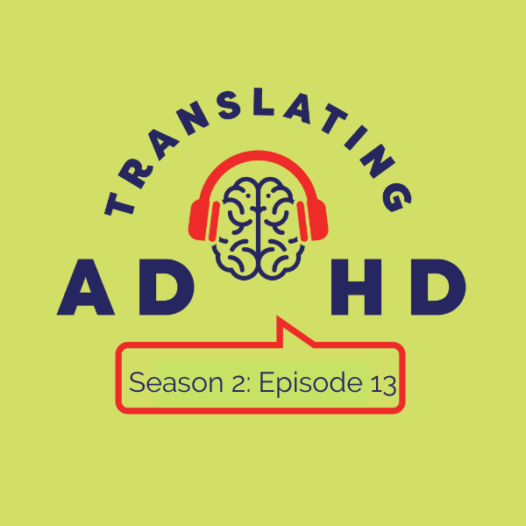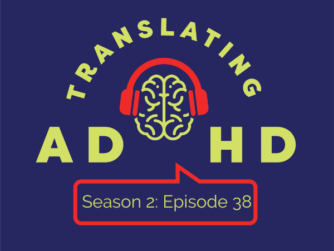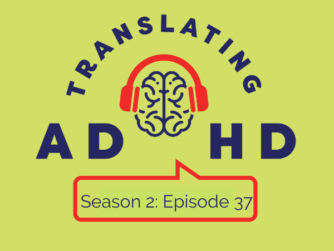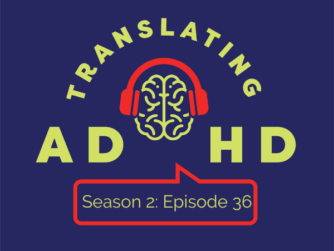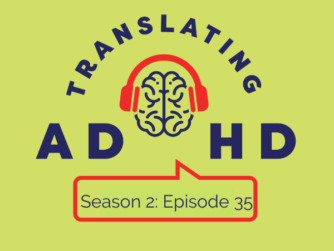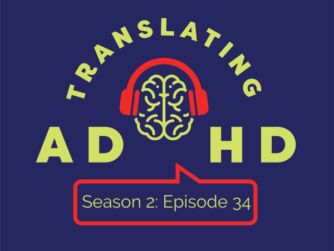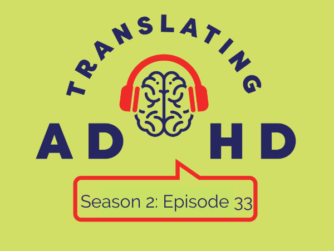In this podcast episode, hosts Ash and Cam continue to discuss the coaching process with an ADHD client – this time one of Cam’s clients. They illustrate the significance of exploring the client’s challenges, assumptions, and initial expectations at the beginning of a coaching engagement to clearly determine the scope or goals of the coaching. The client, a music teacher, initially felt overwhelmed with administrative tasks and the pressure to fill seats in her elective program. She believed the goal would be to address everything that was on her plate. ADHD puts too many things on our plates. The coaching helped her shift her goals to focus more on prioritizing and developing efficient and creative ways to have a better work day. Through experimentation the client realized she could prioritize her classroom experience, connecting with her love for music and education. This shift not only improved her daily experiences but also led to creative solutions, like involving older students to promote the program through engaging activities like Guitar Hero.
The discussion explores the coaching skills and processes used to educate listeners about the change process in coaching. The hosts emphasize the importance of reconnecting with personal values and finding creative approaches to navigate challenges living with ADHD and that good coaches will use the coaching process to help clients define the scope of the coaching work.
Episode links + resources:
For more of the Translating ADHD podcast:
- Episode Transcripts: visit TranslatingADHD.com and click on the episode
- Follow us on Twitter: @TranslatingADHD
- Visit the Website: TranslatingADHD.com
Episode Transcript:
[00:00:00] Ash: Hi, I’m Ash. [00:00:08] Cam: And I’m Cam. [00:00:09] Ash: And this is Translating ADHD. A quick reminder that our next group coaching offering on the brand new topic of Acceptance begins Wednesday, January 24th, and meets at 8:30 PM Eastern on Wednesdays for eight weeks. For pricing and more information about the course and to apply, visit the website TranslatingADHD.com and click on the group coaching tab. So, Cam you want to tell our listeners what we’re going to be talking about today? [00:00:39] Cam: Ash, what we’re going to be talking about today is a continuation of what we did last week. Last week we thought it’d be a good idea to follow the work that you did with a client as they came in. The week before we were talking about readiness for coaching. So what happens when it comes to coaching?And, I thought it was brilliant what we did last week of where the client is, their expectations, their assumptions that they make about the coaching and what they’re expecting to happen and starting to develop awareness, right, of really looking at what are their goals? What are their values? What are their needs? And then what are the obstacles? What are the challenges?
I loved how you started last week with this, the easy lift in the sense of what’s something we can do that’s actionable, that we can focus on, that we can work on where there’s not a lot of other tentacles coming in, you know, others expectations or an environment that’s tough. So that was a great example of someone wanting change, thinking the change was going to happen a certain way. You kind of like navigating that all along, finding her unique value and seeing herself in the picture.
And so that is sort of central to ADHD coaching. This week I was going to just continue with that theme of, I’m going to share the work that I did with a client and that you just kind of switched roles here, right? You’re going to comment on the coaching process there.
[00:02:17] Ash: And Cam, just like last week, why don’t we start with you telling us where this client was when you first began coaching. What did that look like? [00:02:28] Cam: So I’ve been thinking about, I knew this was coming up, and I’ve got a lot of different examples to draw upon. And, I like this one because it’s a little bit different. And I think that the individual when they were seeking out coaching, they were assuming themselves, right? They saw the ADHD coaching piece in my bio. They also saw this, take the lead in your ADHD management, developing skills as a leader. They saw that, and I think they came in thinking with this assumption, I’ve got to develop these leadership skills for me to be successful in what I want to have happen.And just like your client had certain beliefs or black and white thinking about what success looked like, this client assumed, okay, I need to develop specific skills, that they’re going to be uncomfortable. I’m going to do it with this coach, and I’ve got to go through this pathway. And I’m not excited about it, but this is the path I’ve got to go through.
So that was sort of the start of this assumption that I had something, it was in the realm of leadership and ADHD coaching that was going to facilitate the change that had to happen. So it was meeting them there first and foremost, Ash.
[00:04:04] Ash: Cam, this is so interesting because when our clients first come to us, a challenge is a huge signal, and our clients often don’t see their strengths. So when they’re looking for a model for something like leadership, and I’ve run into this with my clients, too, there’s this belief that they have to be someone else. They have to learn how to do it the quote-unquote right way. And this very much sounds like where this client was. [00:04:41] Cam: And it’s so interesting, Ash, how you just in social media and publications, this sort of this idea of what leadership is. And we just can’t get away from this. So this assertive, charismatic individual who is out in front leading, it’s like, why is that?I see leaders as intuitive, creative individuals who are super innovative in how they lead, especially really embracing their wiring. And yet we just put up on a pedestal this sort of picture of the charismatic leader that’s out there, visible, creating change, and it’s so fascinating.
[00:05:24] Ash: Back in season one, we talked about a client of mine who named that personality The Politician. [00:05:30] Cam: Right. That’s right. [00:05:31] Ash: Nothing about politics, but everything about charismatic, quick on their feet, just a certain presence in a room. And yeah, that client thought this is who I need to be. This is what I want to work towards. [00:05:48] Cam: So this particular client was a music teacher in the public school system. And as we started to talk again, listeners, you’ll recall that before I was a coach, I was a teacher. So I’m very fond of teachers and just connected with what she was trying to do.And so her dilemma was everything’s coming at the equal signal. Again, this is pre-COVID. So even after COVID, the demands put upon our teachers are tremendous. But before that, again, it’s doing more with less. With this expectation, you’re going to wear many hats. You’re going to teach your classes, you’re going to do your admin work.
And for her, since these were electives, this was one of the big things that she was bumping up against. Because it was an elective, she had to fill the seats. That was kind of, again, given to her of like, no one’s going to fill the seats for you. You’ve got to develop some marketing plan to fill your seats. And if you don’t, an ultimatum came. If you don’t, the program goes away.
So here’s this pressure. Here’s this expectation that she’s not just teaching. She’s teaching, doing all the administrative stuff and doing all those committees that she has to go to. She has to fill seats in her program, in this whole four-year music program in an upper school. And they’re all presenting, Ash, equally at code red level 11, right? I mean, it’s like all just blaring at her of, pick me, pick me, you’ve got to pick me. So, this is sort of overwhelmed with everything presenting equally and struggling with decision-making.
[00:07:54] Ash: Oof, Cam, that marketing piece in particular, that’s so tough. I run into this a lot with my clients who have found their passion and whatever they’re doing, but are kind of allergic to marketing. You and I are kind of allergic to marketing, [00:08:13] Cam: Completely. [00:08:14] Ash: Right? In terms of that traditional form of razzle-dazzle or whatever it is to get butts in the seats is just a terrifying thought. Was that true for your client as well? [00:08:26] Cam: And again, this, this sense of the exposure of it, right? This is, back before RSD was a named thing. Right. So we knew about rejection sensitivity. We knew about the sensitivity we have as individuals with ADHD, that when our nervous systems are ratcheted up, we can be super sensitive to any kind of criticism or perceived criticism.And it’s so hard for us to distinguish the two. There are just these signals coming in that it’s like, yeah, it’s coming in and you get that slight, that little bit of a, that nonverbal gesture from an admin person, right? Or some administrator, like, well, you got to fill those seats. I mean, it just gives us ample data and it’s like, Oh my God, I’ve got to do this.
So there’s infinite ways to do it. That overwhelm of so many different ways to do that, number one. Number two, that pressure that it can create and this exposure of if I try something and if I fail, then the judgment placed upon me both externally and internally, right? It can come from both directions here.
So often, you know, teachers, they go to teach, they’re not going to do this kind of marketing thing. So, that’s how we started and where we started. I appreciate what you said last week about, again, where did we start? Where did you start with your client was around really looking at self-care?
So where we started was this idea of a better day is just again, a good coach is going to help you bring the focus down in the context to something measurable, something specific to kind of bring that nervous system down from this level 11 and firefighting in all different areas, all different priorities.
[00:10:26] Ash: Yeah. And before you talk about this coaching to a better day, what did this client’s days look like as you were starting to have this conversation? [00:10:39] Cam: That’s a great question, Ash. And that’s part of coaching is this accounting for, right? Is this a good coach is going to ask you. Yeah. So, how is your day going? What happens in your day? And that can be hard to do. And it was like to share that of just, ooh, so in this situation, she’s getting up and scrambling out the door fatigued because she’s getting less than five hours of sleep.So I’ve got two dogs. Yeah. Married, getting out the door, getting into class with minutes to spare, not prepared for lesson plans, and just on her heels all day. And everything again is coming in of just something from an administrator is coming in and it’s just, that she is camped out at that Adrenaline Response Cycle, right? She’s fully in there of reacting to the latest and loudest and that’s it. There’s no strategy. There’s no preparation. She is just reeling. She gets through the day, comes home, walks the dogs, and then collapses on the sofa, right? Just purely exhausted from this effort all day. So that’s her day.
It’s coming and kind of getting through the day, collapsing, and then staying on the sofa through the evening, not being able to engage outside of work, and then it all starts over again.
[00:12:06] Ash: Wow. So, I’m curious if you remember, how did the two of you land on a better day? [00:12:15] Cam: That’s a good question. I went back and looked at our notes from several years ago, so it’s hard to go back to that. I think that as coaches, we’re looking for a place to begin, right? What is a place to begin?And it’s, I think that you know, we want to help our clients sort of stabilize. Be able to stabilize, and what are those crises that we can kind of bring them down? And if there’s some situation, yeah, they’re about to turn out the lights or they’re about to turn off my water, I’m going to help them address that real urgency. It’s sort of distinguishing what was urgent and what was perceived urgent.
And this other thing that had her mind was this winter celebration, right? So, I remember I was in chorus, and we would do this winter celebration, right, where everyone comes in the auditorium, and the music director would get up there with their baton. And we would give a presentation. Well, this was top of mind for her and this is September, right? This is school is starting, and she’s already thinking about December. And this is like super big. I’m like, wait a second. That’s in December. That’s three months away. Let’s focus on the here and now. What can we work on here and now, right now?
And so this idea of, sure, how we got to it. She may have mentioned it, you know? It’s again this, just like, I would love to have a better day. So it’s like, what is that? What is the definition of a better day? So starting to kind of think about the ingredients of that. And she said, it’s like, you know, I’m so depleted at the end. We started to talk about bandwidth and mental energy. And so starting to notice what were the big mental energy drainers and what were the providers. And starting to think about energy conservation and energy distribution, right?
This is back to a spoon theory. And it’s like how many spoons we have and we’re distributing every day. So we’re like counting those spoons to think about how can we collect more spoons and put them in her drawer. And then can we distribute them in ways where she’s getting some return on that emotional energy investment?
And here’s the thing, is that this is, I am remembering this is that feeling really bad about not being prepared for class. And so taking that and let’s convert that into there’s a value here, right? There’s a value here around education, around sharing her love of music with the students.
So that seemed like to me a quick win in the sense of starting to think about, all right, we’re going to prioritize the classroom experience, and if we can get in there and come up with a lesson plan, engage with the students to get them engaged. Because what was happening was she was coming in depleted and they were smelling blood in the water.
I mean, I taught school. I taught school, and I’ve come into situations where I thought I had a plan. I didn’t have a plan. And man, a sophomore, a 15-year-old, who’s sort of like, I’m looking for a little excitement today. They don’t seem like they’re on top of things. Let me have a little fun with that. It just becomes chaos. I mean, it’s a circus.
That was the thing to focus on really thinking about her classes and stabilizing there and her having a better class experience, right? Was then, again, it reciprocated where the kids were more engaged, and instead of this energy depleter, her class experience became an energy provider.
[00:16:13] Ash: Ooh, I want to know more about that here in a moment, how it became an energy provider. But first I want to just say, listeners, listen to the shift that happened here in the coaching. Cam and his client identified something, a piece, a sliver of having a better day that was connected to a positive outcome for this client and sounds like was connected to her why for going into this field in the first place.So not that the administration and the winter concert and the marketing stuff goes away forever. But similar to what I talked about last week with my client, picking something that’s really for the client and that’s going to help put something back in the tank to start to tackle some of these other things. And it sounds like that’s the experience that was happening. But say more about the impact as this client started having a different experience in her classes throughout the day,
[00:17:30] Cam: What it did was it reconnected her with her reason for becoming a teacher in the first place. She’s an educator, but she’s also a musician. Right. And so it’s that marriage of loving music and sharing that love with the students. And that was lost in this sort of state of overwhelm and everything coming in, and again, this level 11. She had misplaced that and was resentful, bitter, tired, thinking I don’t know if I have another year in me.So getting back to this practice, now this is so, I appreciate that question because it’s reminding me of such an important part of coaching. It’s that action part, the experience part of the coaching process. Awareness, action, learning is getting clients connected with something as they have an experiential experience of seeing themselves in the picture again, right? Of, Oh yeah, I’m a musician and I love music. And this is reconnecting me with the thing, why I’m here. Back to the why piece. So that was a central piece.
The other thing I want to say, Ash, is that we’ve talked about like, this idea of neurodivergence, you know, is divergent thinking this being wired differently and wired for context. We talk about like, you know, associative processor versus sequential. She’s an associative in a sequential world. If you think about education and public schools, it is very much about control. It’s about, moving students from one classroom to another. It’s about rules and regulations and all these things that she has to do.
It reminds me of the work that I do often with physicians who have ADHD. Again, they’re wired with this associative wiring by the context of how things are related, how things are connected in this world that is all about status. It’s about hierarchy, it’s about rules. And, again, these conventional methods that kind of can be super exhausting.
So that’s the other thing. I think that we often say, it’s like, I, this is where I think coaches make a big mistake is they just focus on the ADHD. It’s ADHD in the context of their client’s lived experience. Right? What else is informing here? And so that’s another source of this making this exhausting is this highly creative divergent thinker in a world that doesn’t celebrate divergent thinking.
[00:20:25] Ash: So, Cam, as we near the end of our time, you just shared with us that first new experience that your client started to have. And more importantly, what it did for her, reminded her why she was doing this. And now she’s putting herself in the picture. What happened from there? [00:20:48] Cam: Good question. I think this is sort of when you get some early wins and some early momentum and coaching. Then you can start to look at the really interesting stuff. And the early really interesting stuff was back to this idea that she still had in her brain this thinking of I have to fill seats, and it means about me going out and being visible and being a leader and taking charge.And so we turned our attention to that and started to think about the belief system there, her thoughts on that. And she came up with this really interesting collapse distinction around connection and visibility. And this idea that it was all about visibility, the thought of her sitting up there and, with her back to the parents, right?
During that Christmas holiday celebration in December, there’s an auditorium full of parents and relatives behind her looking up and just feeling all those eyes on her, of the judgment that visibility was just overwhelming. It was so overwhelming and had again, talk about emotional dysregulation of just fearing that I don’t want to do that.
And yet here’s this expectation. Who else, you know, does a math teacher put everyone up on stage and do this performance? No, of course not. So this is the expectation of her job is to do the celebration one and one in the fall, one in the spring. And so this is where we started to kind of look at this visibility and tease out, again, how could leadership show up differently, right. To create some space between her and this idea of what leadership had to be versus what it could be.
And what she lit upon was this idea of connection. Connection. My touchstone is connection. I’m looking at the notes here. Visibility is my trigger. Connection is my touchstone and sort of started thinking about it, it’s about connecting with the kids through music and that celebration, right? The December celebration wasn’t about all eyes on her, but it was this chance for the students to connect with the audience. She made it about them, and she started to kind of see herself as a facilitator of this, right. To find it wasn’t about her. She didn’t want it to be about her, but this idea of facilitator and connector started to resonate. And it was so fascinating that she started to bring that into her daily actions.
So quickly, I’ll just go to the whole filling seats and the marketing. She empowered her older kids, the juniors and seniors who were level three and level four guitar players to come, and they would set up a Guitar Hero Station. You remember Guitar Hero.
[00:24:05] Ash: Cam, how could I not remember Guitar Hero? Come now. not that old. Like. Who are you asking? Do I remember Guitar Hero? [00:24:11] Cam: Well people, is Guitar Hero still a thing? I don’t know, but I mean Guitar Hero. So she would have them set up Guitar Hero at lunch. And it became this fun, engaging thing. And guess what? She wasn’t out there trying to talk about her, putting up flyers, but her kids who were good at Guitar Hero, right?They’re having fun. Number one, they’re talented and skilled. Number two, they learn this in this class. And so here they are modeling for the rest of the crew and people start to come over and it’s like, Oh, I can learn how to play guitar in this fun and engaging environment.
But she’s, again, embracing this idea of facilitator to facilitate and identify leadership in others, right? She is tapping the leadership of others to help with these things that she needs to do. So this sort of holistic global way to look at this and kind of, it took her out of this kind of big exposure place, Ash.
[00:25:16] Ash: Looking for leadership in others and looking for others who have different strengths, looking for those kids that would be the kids to do this lunchroom activity. And I love that you use the word modeling, right? I said earlier, that you and I are allergic to marketing and we are, what do we do instead? We model. Be it here on the podcast or in anything else you and I do, presentations, your newsletter and blog, we talk about what we do, and we give good information, and we model that.And here’s this teacher identifying kids who can model, “Hey, this is fun. And it’s a cool skill.” So they’re modeling what she brings to the program without her needing to be front and center. How cool is that? Wow. What a neat outcome.
[00:26:13] Cam: I know. And then this whole idea of like, they took it outside the school to a local coffee shop and sort of showcasing these kids in the coffee shop to take it to the broader community. So it was fascinating how it’s like turning this dilemma, this challenge, into something that was reconnecting the client back to, this is why I do this.And when we have that context, then the ADHD challenge, the challenge becomes less. We start to see that in our, again, we’re honoring our strengths, our values, we’re identifying these challenges. And instead of trying to beat our head against it, it’s like, take a step back, look at it, look for the nuance of it. Get curious about it and find creative ways to navigate those barriers that we’ve been talking about for several weeks now.
[00:27:11] Ash: Well said, Cam. And I think this is a good place for us to wrap this episode for today. Thank you so much for bringing this client experience. I always love, not even my client, and I’m over here, all giddy and happy because it just hits me right in my coach feels, right. Such rewarding work as a coach when you see a client shift over time and step into the powerful, unique person full of strengths that were always there, were just buried under the other stuff. So until next week, I’m Ash, [00:27:46] Cam: And I’m Cam. [00:27:47] Ash: And this was the Translating ADHD podcast. Thanks for listening. And by the way, did I get the last word for once? Wow. [00:27:57] Cam: No, no you didn’t. [00:27:59] Ash: Yes, I did.
